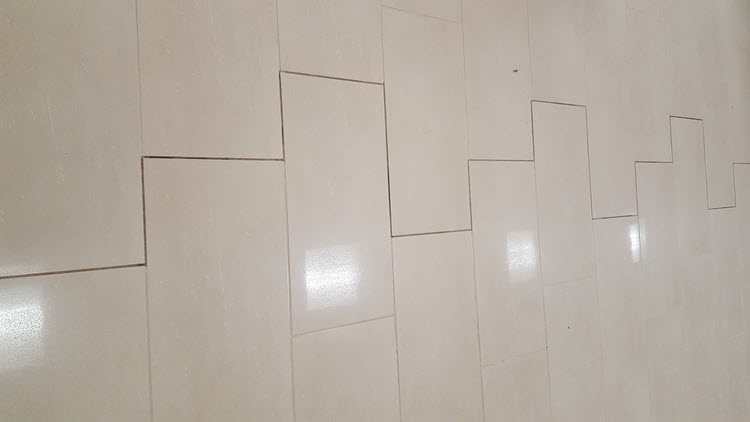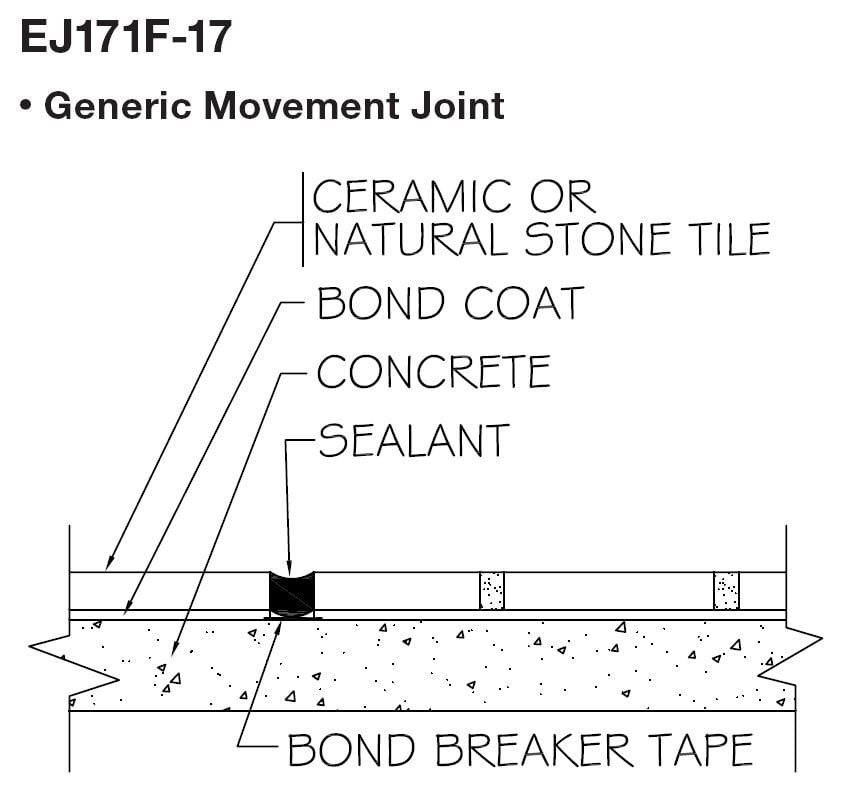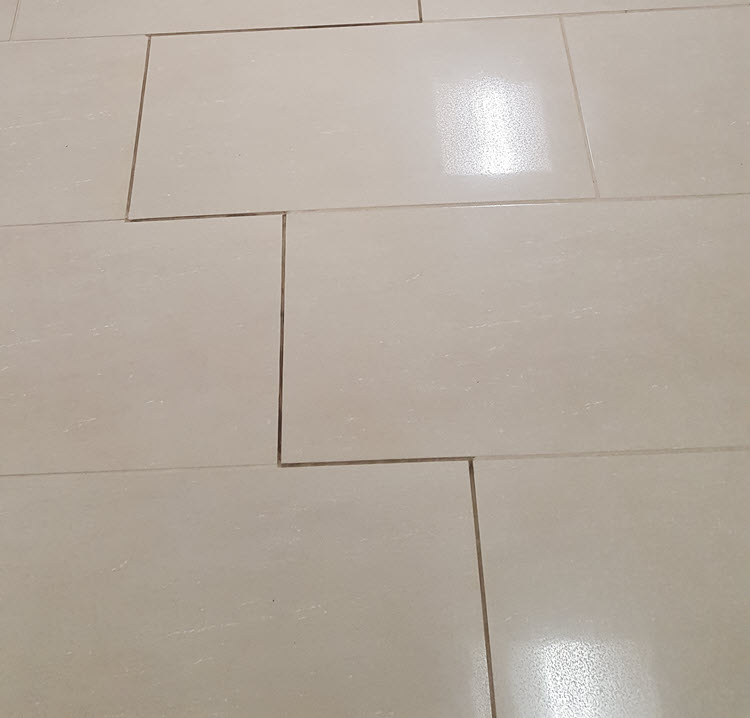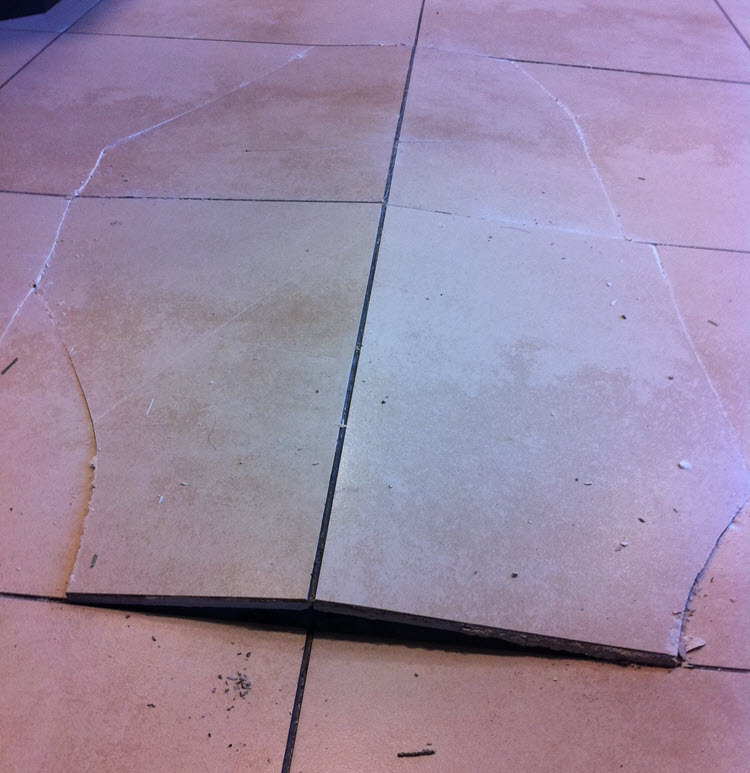
How do you deal with expansion joints in an installation that is non-linear? You can't ignore them or you'll wind up with a nasty surprise. You can't necessarily change your tile layout so your movement joint is linear. So what can you do?
Luckily, there's an ANSI standard available to help you address this situation.
3 Reasons Why Expansion Joints Matter
In case you do think you can ignore movement or expansion joints, here's a refresher on why they matter.
1. Buildings Experience Movement
Buildings experience significant movement on a day to day basis and a successful ceramic, porcelain, and/or glass tile installation must accommodate this movement.
Although you'll find many causes for movement in a structure, temperature and moisture changes play a large role.
2. Temperature Affects Buildings and Tile
As beautiful and functional as ceramic and porcelain tiles are, they are very greedy when it comes to the space needed around them to absorb any movement.
In fact, when a surface such as a tile floor becomes warm or hot to the touch from direct sunlight or in-floor heating, it expands, growing larger. When the sun disappears and/or the heat cycles off, the floor cools and contracts, growing smaller.
The movement is much like the action of the musical instrument, the accordion. The in and out motion is similar to that of a floor that can expand and contract many times per day.
3. Movement Joints Prevent Tile Tenting
Allowing little or no room for the tile assembly to expand can cause the tile to pop up or “tent” in the middle of the floor. This situation occurs in both commercial as well as residential jobs, so none of them are exempt from this requirement.
This resulting expansion and contraction must be accommodated or the tile assembly may rebel by shearing away from the substrate and moving upward in what is known as “tenting”.
The image above was from a large tiled area between the elevator cars and the sixteen-foot floor-to-ceiling windows with Southern exposure. There were no expansion joints in the field tile and no perimeter joints along the elevator wall or the window wall.
The hot sun plus a large tiled area with no allowance for movement led to a tented disaster.
Tile Industry Guidelines for Movement Expansion Joints
Luckily, you have guidelines for movement expansion joints in the American National Standards Institute (ANSI) publication:
The ANSI A108.01 document provides the following standards:
Section 3.7.3.1 – Interior areas exposed to direct sunlight shall have expansion joints spaced at 8 ft. – 12 ft. (2.4 M – 3.5 M). These joints are necessary in both north/south and east/west directions.
Section 3.7.4.1 – Unless otherwise specified, use sealants complying with ASTM C920, which designates sealants according to types, grade, class, and uses. Back-up strip shall be a flexible and compressible polyurethane and, rounded at surface to contact sealant and as recommended by sealant manufacturers. It must fit neatly into the joint without compacting and to such a height to allow a sealant of 1/2 the width of the joint. Sealant must not bond to the back-up material.
The ANSI A108.02 states:
Section 4.4.2 – Movement joints area are a requirement for tilework.
This expansive growth must be accommodated with shock absorber-like areas known as expansion or movement accommodation joints. Since grout joints do not offer any movement-absorbing qualities, these joints must be filled with a resilient material such as 100% silicone, urethane, of polysulfide. The Tile Council of North America (TCNA) Handbook, in section EJ171, clearly shows the shape, size, and location of these shock absorbers.
>> See Why Do You Need Expansion Joints When Installing Tile?
3 Expansion Joint Challenges Including Non-Linear Ones
1. Who's Responsible for Installing Expansion Joints?
Sometimes the reason that expansion joints don't happen is because there's fuzziness around who's responsible for installing them.
- If the job is designed and detailed by an architect, has s/he included expansion joints in the project specifications?
- If there's no architect, has the tile installer addressed this requirement?
2. How to Complete a Soft Movement Joint?
Once the tile installer has determined the type, size, and frequency of the expansion or soft joint, completing the joint installation is easily completed.
The joint must be free of any grout or mortar and completely dry.
The detail may call for a foam backer rod to be placed in the bottom of the joint, but in many applications such as over a concrete slab or backer board, a generic joint may be necessary.
 As seen in the attached drawing, a bond breaker tape should be installed at the bottom of the joint to keep the sealant from bonding to the surface below. This product can most times be difficult to find.
As seen in the attached drawing, a bond breaker tape should be installed at the bottom of the joint to keep the sealant from bonding to the surface below. This product can most times be difficult to find.
Here's an easy and inexpensive alternative: sprinkle a small amount of granular material such as dry sand, thin set, or grout into the joint. Be certain that you've cleaned any excess material off the surface before applying the sealant.
- Apply the proper sealant (no acrylic latex or siliconized caulking) using a caulking gun.
- Carefully fill the joint completely.
The next step is really critical to a successful installation.
- Using a pump sprayer, filled with a small amount of dishwashing detergent and water, liberally coat the sealant and the tile surface.
- Smooth the sealant with a sealant tool or a plastic spoon. The sealant will not stick to the tile but will stay on the spoon until the joint is completed.
- Allow the sealant to dry overnight, then wash the area with a wet sponge until the soap residue is gone.
>> See Quick and Easy Movement Joints... the Right Way
3. What To Do About Non-Linear Expansion Joints?
So let's get to the heart of this article: dealing with non-linear movement joints.
Traditionally, movement joints required placement in a straight line. That's just about impossible with twelve by twenty-four- inch or other rectangular tile (think planks!) that require 33% offsets.
>> See Grout Joint Offsets and Wood Plank Tile

In the past, the solution was to cut the tile in a straight line, filling the joint with 100% silicone, urethane, or polysulfide sealant which worked effectively.
However, it was also a major turnoff to designers and consumers who resisted this situation saying, “I don’t want my beautiful pattern to be destroyed by those ugly joints. Not on my watch!” You can imagine the result of this scenario: the installer was at a great risk for the installation to fail, possibly resulting in tented tile.
Luckily, you'll find standards for formerly “only” straight joints to follow the non-linear joint configurations as seen in the image above utilizing the required 33% offset.
ANSI A108.01 – 3.7.5 Non-linear movement joints states,
“Generic movement joints, or field joints not over an existing expansion joint in the subfloor or wall, can be installed in a non-linear configuration resulting from the use of tile patterns (e.g. saw-toothed, zipper, etc.). The movement joint must be a properly designed generic movement joint per TCNA EJ171, and the sealant shall meet ASTM C920, or as indicated in the project specification. The intended application must be approved by the sealant manufacturer, and the sealant must be properly installed per the sealant manufacturers’ requirements.”
In my mind, this is a win-win situation for all involved. The installer gets the expansion joint he or she must have to handle the movement caused by sunlight or moisture while the designer and/or consumer get the tile installation pattern dreamed of.
Have You Had to Deal with Non-Linear Movement Joints?
Let us know in the comments how you've dealt with non-linear movement joints since they are so critical.
If you're an installer and still wondering, consider learning more about the Certified Tile Installer program.
Thanks for reading and please tell your friends where you found this information.
Scott
Note: This is one of Scott's classics from 2020 that we've updated to share with you.


